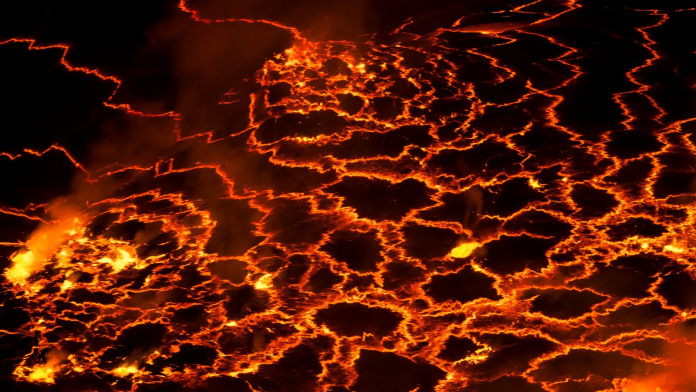In a strange corner of our solar system live two alien blobs.
With sprawling, amorphous bodies the size of continents, these oddities are thought to spend their time lying in wait for their food to rain down upon them – then simply absorbing it.
But their natural habitat is, if anything, even more unusual than their diet. It could be described as “rocky” – all around, there are exotic minerals in unknown shades and forms. Otherwise it’s fairly barren, except for a glittering sea in the far distance – one so large, it holds as much water as all of Earth’s oceans put together.
Every day the “weather” is the same: a balmy 1827C (3321F), with some areas of high pressure – equivalent to around 1.3 million times the amount at the Earth’s surface. In this crushing environment, atoms become warped and even the most familiar materials start to behave in eccentric ways – rock is flexible like plastic, while oxygen acts like a metal.
But this blistering wonderland is no extra-terrestrial planet – and the blobs aren’t strictly wildlife. It is, in fact, the Earth itself – just very, very deep underground.
In particular, the setting in question is the lower mantle – the layer of rock that sits just above Earth’s centre, the core. This mostly-solid mass is another world, a place that’s swirled and flecked with a kaleidoscope of crystals, from diamonds – there are around a quadrillion tonnes of them in the mantle in total – to minerals so elusive, they don’t exist on the surface.
Indeed, the most abundant rocks in this layer, bridgmanite and davemaoite, are largely mysterious to scientists. They need the ultra-high pressures unique to the interior of the planet to develop, and break up if they’re brought into our own realm – the geological equivalents of the outlandish deep-sea fish that melt when they’re trawled up from the bottom of the sea.
These elusive minerals can only be seen in their natural form when they become trapped inside diamonds brought to the surface. Even then, what these crystals would actually look like deep inside the Earth is impossible to predict, because their physical properties are so altered by the pressures they usually exist under.
Meanwhile the distant “ocean” doesn’t contain a drop of liquid. Instead it’s made from water trapped within the mineral olivine, which makes up more than 50% of the upper mantle. At deeper levels, it transforms into indigo-blue ringwoodite crystals.
“At these depths, the chemistry changes totally,” says Vedran Lekić, an associate professor of geology at the University of Maryland in the US. “For all we know there are some minerals that would become more transparent,” he says.
However, it’s the deep-Earth “blobs” that are currently gripping geologists around the globe.
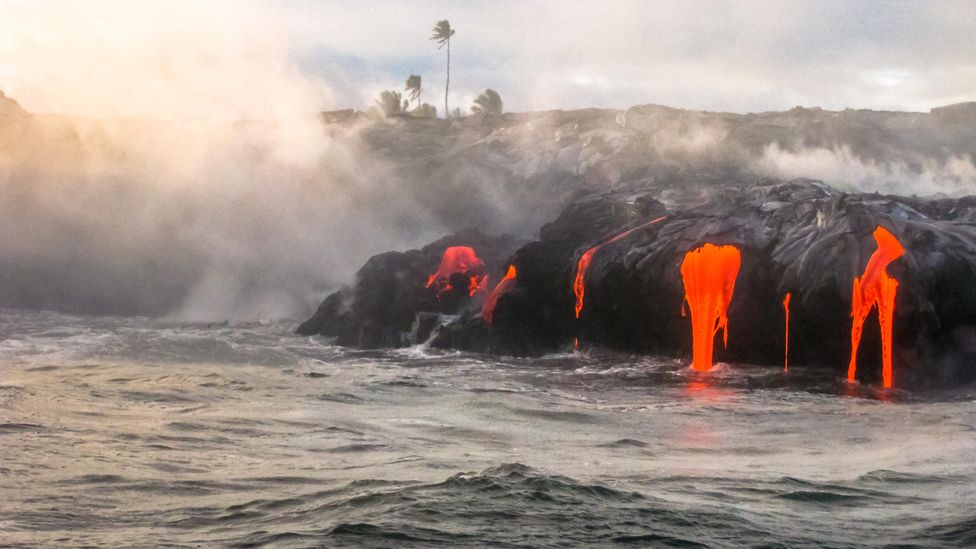
Hawaii’s volcanoes are unusual, because they’re in the middle of a tectonic plate (Credit: Alamy)
The structures are thousands of kilometres wide and occupy 6% of the volume of the entire planet. Estimates of their heights vary, but one – found under Africa and known affectionately as “Tuzo” – is thought to be up to 800km (497 miles) high, equivalent to around 90 Everests stacked on top of each other. The second – “Jason”, below the Pacific – might extend 1,800km (1,118 miles) upwards, translating to around 203 Everests. Their misshapen forms are moulded around the Earth’s core like two amoebas clinging to a speck of dust.
“These features are very large, very prominent in tomography [a kind of imaging],” says Bernhard Steinberger, a geodynamics researcher at GFZ German Research Centre of Geosciences and the University of Oslo in Norway. And though these titanic shapes are almost certainly there, almost everything else about them remains uncertain – including how they formed, what they’re made of, and how they might be affecting our planet.
Crucially, understanding the blobs could help to unravel some of geology’s most enduring mysteries, such as how the Earth formed, the ultimate fate of the “ghost” planet Theia, and the inexplicable presence of volcanoes in certain locations around the globe. They may even shed light on the ways the Earth is likely to change over the coming millennia.
A tricky problem
In 1970, the Soviet Union embarked on what was arguably one of the most ambitious exploration projects in human history – they attempted to drill as far as possible into the Earth’s crust. This solid layer of rock, which sits above the mostly solid mantle and, eventually, the Earth’s partially molten core, is the only part of the planet that has ever been seen by human eyes. No one knew what would happen if they tried to get through it.
By August 1994, the Kola Superdeep Borehole, set amidst a bleak expanse of Arctic tundra in northeastern Russia, had reached staggering depths – stretching some around 12,260m (40,230ft) underground. But then the drill got stuck.
When they started, the team running the project made predictions about what they expected to find – specifically that the Earth would get one degree warmer for every 100m (328ft) that they travelled towards its centre. But it soon become clear that this was not the case – in the mid-1980s, when they reached 10km (6.2 miles), it was already 180C (356F), nearly double that expected.
In these extreme conditions, the granite eventually ceased to be drillable – it was behaving more like plastic than rock. The experiment was halted, and no one has managed to pass the crust’s threshold to this day. The only remaining hint of the Kola borehole’s existence is a rusty metal cap embedded in the ground.
“We really know much less about the Earth’s mantle than about outer space where we can look with telescopes, because everything we know is very, very indirect,” says Steinberger.
So, how do you study an environment that you can’t view or access, where the chemical properties of even the most ordinary materials become distorted beyond all recognition?
As it happens, there is another way.
Seismology involves studying the waves of energy produced by the sudden movement of the ground during massive events such as earthquakes. These include so-called “surface waves”, which are superficial, and “body waves”, which travel through the interior of the Earth.
To pick them up, scientists use instruments on the opposite side of the world to the earthquakes they’re detecting, and examine whatever has managed to wiggle its way through. By analysing the different wave patterns that result, they can start to piece together what might be going on hundreds of kilometres underfoot.
It’s these features that allowed the Danish geophysicist Inge Lehmann to make a major discovery in 1936. Seven years earlier, a large earthquake in New Zealand had led to a surprising seismic result: one type of body wave, which can travel through any material, had made it through the Earth – though they had been “bent” by some obstacle along the way. Meanwhile, another kind, known to be unable to traverse liquids, had not been able to pass. This overturned the long-standing belief that the core is entirely solid, and led to the modern theory there is a solid inner enveloped in a liquid outer layer – a sort of reverse coconut, if you will.
A mystery from the deep
Eventually the method was refined, meaning it was possible to not only peer beneath the Earth’s surface – but to visualise its hidden depths in three dimensions. “We use the same kinds of techniques as in computer assisted tomography, CAT scans [a kind of medical imaging involving X-ray images]. In fact, we do tomography of the inside of the Earth,” explains Lekić, of those in his field.
Almost immediately, this led to the discovery of the Earth blobs.
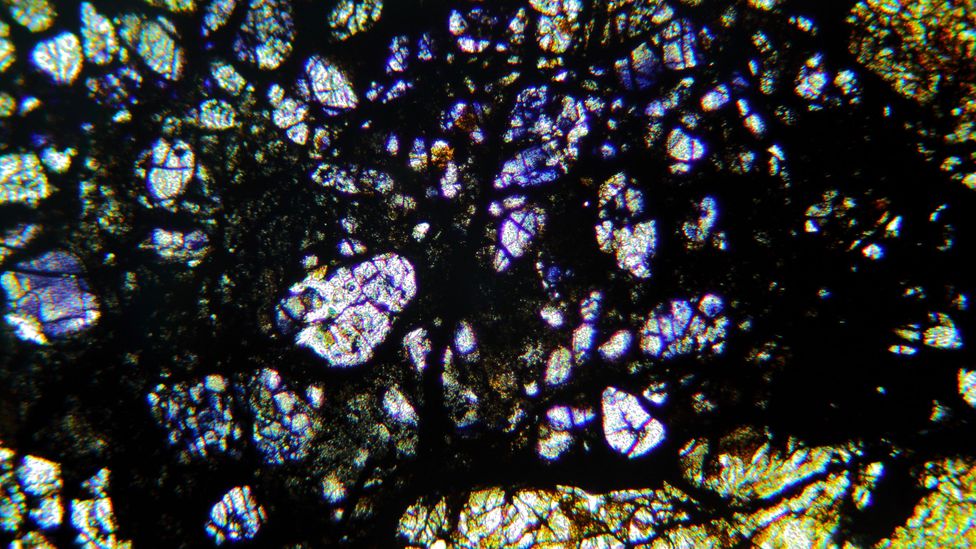
Many of the most abundant materials found deep inside the earth have rarely been seen at the surface (Credit: Wikimedia Commons/Ringwoodit)
Though the mantle was previously thought of as a homogenous layer, geologists detected two colossal regions inside it, one that straddles Africa and one below the Pacific Ocean, where earthquake waves encounter resistance and slow down. Just as with the Earth’s core, these areas are clearly different from the rest of the mantle – in fact, they represent some of the largest features on the planet.
These are the large low-shear-velocity provinces, or LLSVPs. It’s tricky to find any familiar analogue for their peculiar forms – they could be described as unusually bulbous mountains or mounds, though Lekić wouldn’t use those words himself. “They’re bigger than continents,” he explains.
Intriguingly, the structures seem to have a closer resemblance to colossal piles of sand – one study found that they had sharp slopes in places, as well as shallow ones and even a few overhangs. Amidst the debate about their appearance, the features have come to be known as blobs.
But the LLSVPS’ puzzling appearance is nothing compared to the confusion surrounding how they formed – or even what they’re made of.
“So there is 100% certainty that these two regions are, on average, slower [in terms of how quickly earthquake waves move through them] than the surrounding region. That is not up for debate,” says Lekić. “It’s like climate change. It’s an observation, not a theory. The problem is that our ability to see in that region is blurry.”
So, though scientists know that there’s something going on there, they’re yet to discover exactly what they’re looking at.
A clue has emerged from another long-standing source of bafflement – if the LLSVPs are made from the same stuff as the rest of the Earth’s mantle, they’re breaking a fundamental law of physics. That’s because the blobs seem to be simultaneously hotter than the surrounding rock, and more dense.
Just like a stubborn jar lid that has been run under a hot tap to release it, materials tend to expand when they’re heated up, making them less dense. This is hard to reconcile if the blobs are made from plain old silicates like the rest of the mantle, the dominant mineral found in granite and sandstone.
As a result, it’s thought that the blobs must have a different chemical makeup to the surrounding rock – perhaps they’re composed of minerals that are unusually rich in something heavy, like iron or nickel. “But there are different ideas of how this comes about,” says Steinberger. And this is where it gets interesting.
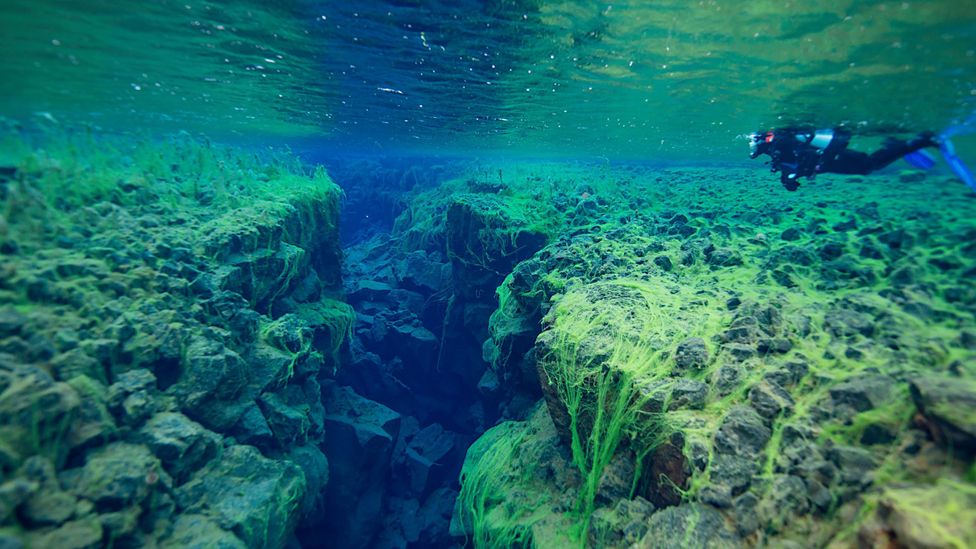
Most volcanoes form where two tectonic plates meet – but there is also another kind (Credit: Alamy)
The earliest idea is that the blobs are truly ancient, dating back billions of years to the primordial Earth, when our planet was still forming and its mantle – which is now made of solid rock – was an ocean of molten magma. As the minerals in this layer began to harden and crystalise, some regions held onto impurities that had been mixed in when it was still a liquid. These have remained in place for all this time, and today they form the strange LLSVPS.
Back in 2014, an international team of geologists – including Steinberger – calculated that this kind of blob could easily last three billion years, even though the Earth’s mantle is always swirling around gently, as hotter parts rise and cooler ones descend.
“And one reason for them not deforming much could be that they’re very rigid,” says Steinberger.
Another possibility is that the blobs were formed by tectonic processes. As children learn in school, the Earth’s crust is cracked into tectonic plates, which are constantly moving around and slipping underneath – as well as over the top of – one another.
Some geologists believe the LLSVPs may be made from these broken-off pieces of crust, which sink to the bottom of the mantle and form lumpy structures that have a different chemical make-up to the surrounding rock.
In fact, research suggests that if you add up the total amount of crust that has ever melted back into the deep Earth, it amounts to 7-53% of the volume of the planet – more than enough to account for the size of the blobs. “The crust is being stripped off and added to those piles,” says Steinberger.
In this scenario, the LLSVPs are composed of the mostly basalt rock that has drifted down from heavy oceanic plates that were pulled under. But even sedimentary rocks that were once burrowed into by ancient fish, or that contain the remains of long-vanished ocean creatures like plesiosaurs, could eventually end up near the centre of the Earth this way – though they make up a tiny proportion of the Earth’s crust. Essentially, the blobs are a geological graveyard.
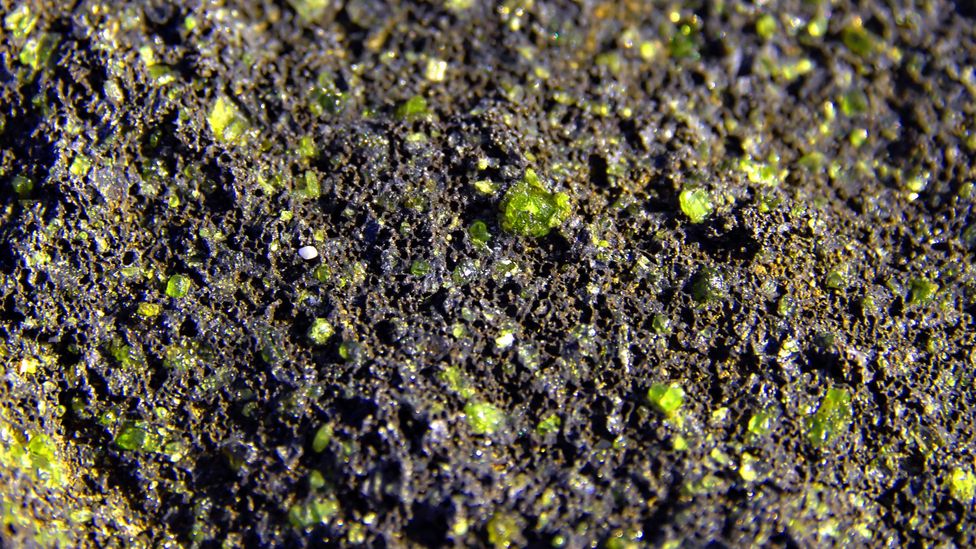
If the volcanoes in the Hawaiian archipelago are created by mantle plumes, lava from this region may provide insights into the composition of the deep earth (Credit: Alamy)
A third proposition is that long after the Earth formed, iron somehow seeped out of the Earth’s core and ended up in the mantle. This was incorporated into the rock in some areas, leading to the development of the strange blobs. However, Steinberger says this idea is not particularly popular – there’s currently no clear reason why this would happen.
Then last year, a team of scientists from Arizona State University had a bold thought: what if the blobs were aliens – of a sort – after all?
It’s a little-known fact that there are actually three celestial bodies in our little patch of the Solar System – the Earth, the Moon, and Theia. Today, the latter is little more than a ghost, after smashing into our planet 4.5 billion years ago. For decades, it was thought that when this small Mars-sized planet collided with the infant Earth, the resulting debris – mostly from the other planet itself – coalesced to form the Moon.
But there are problems with this idea, such as the fact that the Earth and the Moon share similar chemical signatures – as though they were created out of the same material.
Instead, the researchers have suggested an alternative. After slamming into the early Earth, Theia became mixed up with its inner contents, forming part of the mantle. Meanwhile, the Moon formed not from the extra-terrestrial planet itself, but the shards of the earth that were blasted out.
The twist is that Theia didn’t mix into the Earth in its entirety. Most of it was so dense that it wasn’t affected by the currents within the mantle – in fact, the foreign planet exists as lumps inside the earth to this day. It’s possible that these are the LLSVPs, and there are fragments of an alien world lurking deep beneath our feet.
A hidden influence
Whatever they’re made of, there’s a growing consensus that the Earth’s strange blobs, as distant as they seem, are affecting life at the surface in tangible ways.
For a start, they may be influencing how volcanoes are distributed.
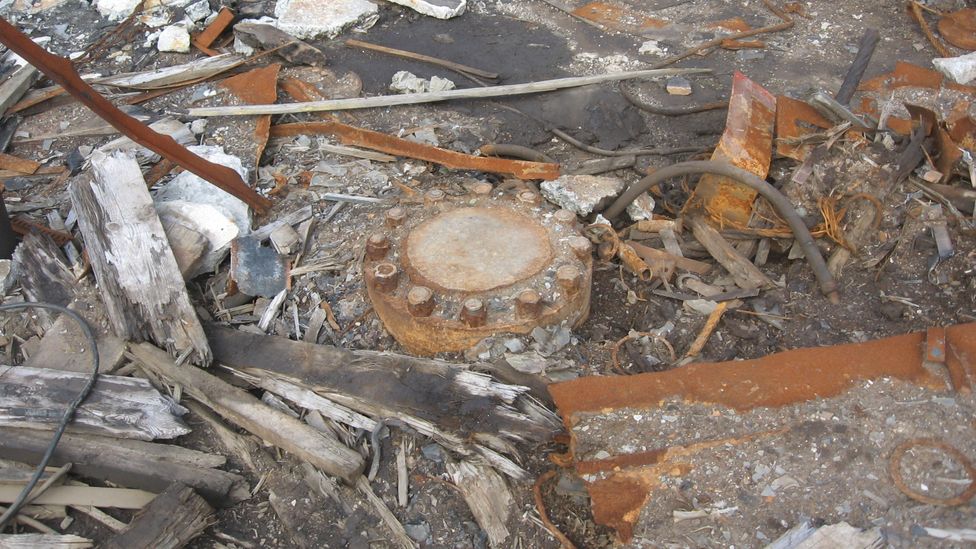
No one has ever managed to venture beyond the Earth’s crust (Credit: Wikimedia Commons/ Rakot13)
Most of the world’s most famous geological flashpoints – such as the Ring of Fire, a 25,000-mile-long (40,233km) chain of volcanoes circling the Pacific Ocean – are found above the places where tectonic plates meet and jostle for space. But oddly, some highly active areas don’t follow this pattern. The Hawaiian Islands, in the North Pacific Ocean, are home to six active volcanoes, as well as extensive lava fields and some places where magma bubbles up almost continuously. This is despite the fact that they sit safely in the middle of the Pacific Plate, thousands of miles from any others.
One explanation is so-called “mantle plumes”, theoretical hotspots in the Earth’s lower mantle where rock is that’s hotter than its surroundings rises up, forming tree-like networks of vertical channels all the way to the crust. They begin in the layer directly around the core, the interior of which can reach the same temperature as the surface of the Sun.
“Basically, they form because the core is relatively hot compared to the overlying mantle, so thermal instabilities develop” says Steinberger. He compares it to boiling a pan of water on the stove – it’s never heated entirely evenly, so you get bubbles forming in some places and not others.
Wherever these blistering zones seem to meet the surface of the Earth, you can usually find volcanoes.
There is a catch, however. The concept of mantle plumes was first proposed as far back as the 1970s, and they remain almost as mysterious as the LLSVPs. “In recent years the evidence [for them being real] from seismic tomography has been getting stronger and stronger,” says Steinberger. “So there’s hardly anybody who has doubts about their existence. But then, of course, there’s many things that are not so sure about them,” he says.
Today it’s possible to make basic maps of mantle plumes using seismology. And back in 2008, geologists discovered something intriguing: they’re almost all located at the edges of the Earth blobs.
This has led to a chicken-and-egg – or rather, blob-and-volcanic hotspot – scenario. Are these regions more geologically active because the blobs are there already? Or are the blobs located where they are because the hotspot activity is somehow pushing them into these positions?
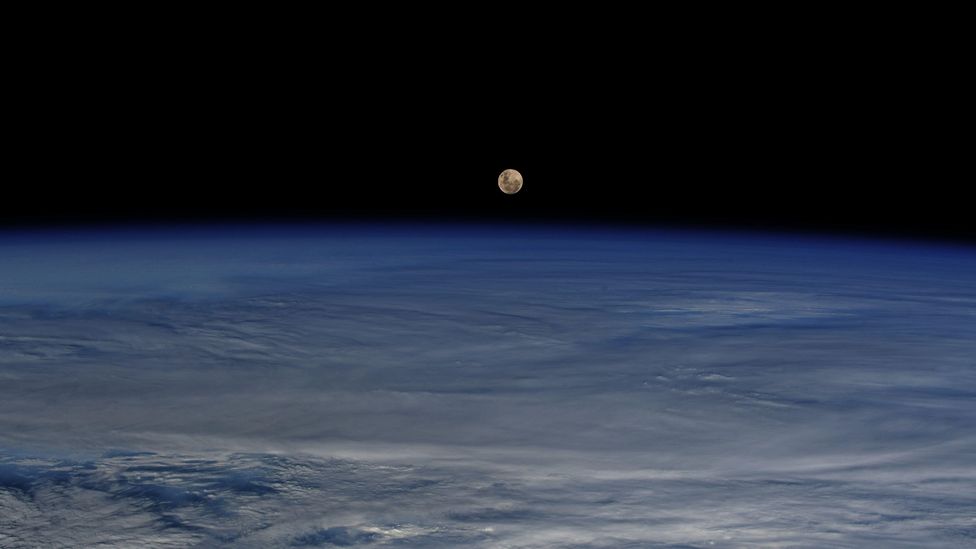
For years, scientists believed that the moon was primarily made of the ex-planet Theia, which crashed into the Earth 4.5 billion years ago (Credit: Alamy)
It might happen something like this. Ocean plates which sink into the Earth’s depths eventually end up near the bottom of the mantle, where they form the blobs – oddly, at these depths they’re more dense than the surrounding rock. These form a kind of insulating blanket above the core, preventing the super-hot regions in that give rise to mantle plumes from developing beneath them. So they form around the edges instead. In this way, you end up with mantle plumes 2,891 km (1,796 miles) above the borders of the blobs, in our own earthly realm. It looks like the LLSVPS are encouraging them to develop at particular locations.
If this is the case, it suggests that these peculiar hidden structures are having a profound impact on our planet – effectively dictating where certain groupings of volcanoes occur, as well as the island chains that they create. The Hawaiian archipelago wouldn’t exist without them – and neither would China’s Hainan Island.
And the LLSVPs may have an even wider remit. Scientists have long wondered why the Earth spins on its axis at the angle that it does – in other words, why is the North Pole in the Arctic, and not somewhere else? While many factors are thought to contribute to minor “wobbles” either way, including climate change, the earth’s axis has remained broadly stable for billions of years.
One intriguing observation is that the Earth blobs sit neatly on either side of the axis – hinting that either they migrated there because of the earth spinning, or they are influencing the way it does it.
Exactly how the LLSVPs could be affecting the planet’s inertia is hard to pin down, because their shapes are so irregular and uncertain. But Lekić has made a map that shows the consensus view of where they’re located. “What you see is the Pacific one ends up being kind of elongated east-west, and the Africa one ends up being kind of elongated north-south,” he says.
Lekić compares the way the blobs could be affecting the Earth’s axis to spinning a book – it’s much easier to do it flat than along the spine – having the weight distributed laterally makes the spin more stable. “In general, spinning bodies try to distribute the mass so that the mass is closest to the equator, as far away from the spinning axis as possible,” he says. “And so for the earth, that is the LLSVPs. The component of their structure that would affect spin is perfectly aligned with the equator, which suggests that the Earth’s rotation axis kind of has migrated to the point where essentially, you have these two kind of heavy things [either side].”
So, though the deep-Earth blobs are still as baffling as ever, they’re already set to reveal some of our planet’s secrets – and possibly even some from a long-lost alien world. Perhaps one day we’ll find an even better way to peer inside the Earth to see them.
*The video of the LLSVPs has been reproduced with permission from Vedran Lekić. It was originally published in the 2016 paper Morphology of seismically slow lower-mantle structures by Sanne Cottaar and Vedran Lekić.
—
Zaria Gorvett is a senior journalist for BBC Future and tweets @ZariaGorvett
—
Join one million Future fans by liking us on Facebook, or follow us on Twitter or Instagram.
If you liked this story, sign up for the weekly bbc.com features newsletter, called “The Essential List” – a handpicked selection of stories from BBC Future, Culture, Worklife, Travel and Reel delivered to your inbox every Friday.

